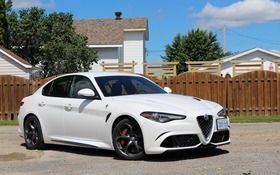2017 Alfa Romeo Giulia Quadrifoglio: Love at First Sight

| Strong points |
|
|---|---|
| Weak points |
|
Alfa Romeo’s return to the North American market was a timid one, but in the last year, things have picked up considerably. The Giulia compact sedan has been on sale for a few months now, and the Stelvio compact SUV is just arriving.
They share the same platform and powertrains, so development and production costs have been reduced for both models, and although there are still very few dealerships in Canada, the brand is slowing establishing itself here.
- Also: 2018 Alfa Romeo Stelvio: The Italian-Style SUV
- Also: 2017 Alfa Romeo Giulia Quadrifoglio: A Place Among the Great Names of the Industry
The Giulia isn’t just a pretty face. It’s got a powerful, 280-horsepower base engine, available all-wheel drive and great driving dynamics. However, with the 2017 Alfa Romeo Giulia Quadrifoglio, the Italian automaker is hunting down the 425-horsepower BMW M3, the 464-hp Cadillac ATS-V and 503-hp Mercedes-AMG C 63 S.
Under its vented, carbon-fibre hood is a twin-turbo, 2.9-litre V6 engine that develops a whopping 505 horsepower and 443 pound-feet of torque, bolted to an eight-speed automatic transmission. As for as output goes, it whips the M3’s and the ATS-V’s butts, and although it boasts a couple more ponies than the C 63’s twin-turbo V8, the latter trumps it in the torque department with 516 pound-feet.
Like its competitors, the Giulia Quadrifoglio boasts a rear-wheel drivetrain. Zero to 100 km/h in the Alfa is estimated at 3.9 seconds, which is blisteringly quick. Top speed is a claimed 307 km/h.

However, to extract that level of performance, the driver must activate the Race mode. The engine gets louder, the car’s reflexes get sharper, but the electronic stability control system is switched off. Great for track use, but on the open road, to unlock the full potential of the Quadrifoglio’s powertrain, we lose a valuable safety net. In comparison, you can switch on a Sport or Sport+ mode in its rivals, and in some cases, press a button to independently activate the full sound of the exhaust. In short, being a douchebag in the Giulia Q is at our own risk.
Weighing in at about 3500 lbs, the car is no featherweight, but we can’t pinch any fat on its body either. The use of weight-saving materials, such as carbon fibre, helps keep the Giulia agile, and thanks in part to its near-perfect 50:50 weight distribution, as well as the sticky 245/35ZR19 front and 285/30ZR19 rear performance tires, the car handles beautifully. Alfa Romeo’s heritage is all about speed and dynamics, and the Giulia Quadrifoglio fits in perfectly.
Fuel economy is reasonable considering the engine’s output and the car’s mission. We averaged 10.7 L/100 km during our test.
Beauty is in the eye of the beholder, but we have to admit that the 2017 Alfa Romeo Giulia boasts seductive bodywork. The Quadrifoglio drew stares everywhere it went, and gained the admiration of the valets at an underground hotel parking lot, who fought amongst themselves to be able to park the car 30 feet away. Their admiration faded a little after having to repeatedly turn off the Giulia’s alarm system, which was set off by the vibration of the nearby passing of the subway.
Alfa’s signature, triangular grille design prevents the installation of a centre-mounted license plate, which means it must be screwed into the Giulia’s left cheek, making it look like a giant acne pimple on a supermodel’s face. Otherwise, the car looks great from every angle.
The Quadrifoglio’s cockpit design is also quite attractive, with carbon fibre trim, red contrast stitching and circular air vents. However, the quality of some plastics doesn’t reflect the car’s price tag. The heavily bolstered, leather and Alcantara trimmed seats keep you firmly in place during spirited driving, and the column-mounted paddle shifters are huge, so easily accessible. On the other hand, those paddles are always in the way when we’re reaching for the turn signal or windshield wiper stalks.
Unlike almost all Fiat Chrysler Automobiles products, the 2017 Alfa Romeo Giulia isn’t equipped with a Uconnect infotainment system, but the brand’s own interface. In the Quadrifoglio, we get an 8.8-inch widescreen that isn’t touch-sensitive, accompanied by a console-mounted rotary dial that includes a gesture recognition pad on top of it for scribbling letters and numbers with our finger. This system takes some getting used to, and it isn’t as user friendly as the Uconnect setup. In addition, the navigation map is wide, but not very high, making it difficult to see the roads coming up ahead—if we set the map’s orientation to point upwards, that is.

The Giulia Quadrifoglio doesn’t feel like a precision-crafted machine like the M3 and C 63 S do, but that’s arguably part of the car’s charm. While the German sedans can feel a little cold, the Q has character and emotion. Even at idle, it shakes like an old muscle car. It’s Italian after all.
Priced at $87,995 before freight and delivery charges, though, the Quadrifoglio is a costly beast. The M3 with an automatic transmission starts at about $80K, while the C 63 S is listed from $85K (the 469-hp C 63 goes for $76K). The ATS-V is the bargain of the group at $66K.
And then there’s the inevitable question of reliability. Alfa Romeo, and Italian automobiles in general, have never been known for being trouble-free, although some would argue that this is also part of their character. All the cars mentioned here should be considered high-maintenance machines, though.
It’s fast, it’s sexy and it’s got plenty of charm. The 2017 Alfa Romeo Giulia Quadrifoglio is also a rare sight on our roads, at least for now. Its ownership comes at a cost, but the reward is a car that leaves no one indifferent.











